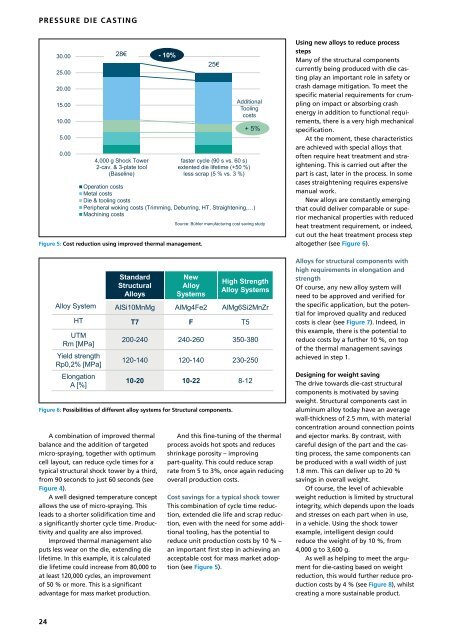CPT International 4/2019
Create successful ePaper yourself
Turn your PDF publications into a flip-book with our unique Google optimized e-Paper software.
PRESSURE DIE CASTING<br />
30.00<br />
25.00<br />
20.00<br />
15.00<br />
10.00<br />
5.00<br />
0.00<br />
28€<br />
4,000 g Shock Tower<br />
2-cav. & 3-plate tool<br />
(Baseline)<br />
A combination of improved thermal<br />
balance and the addition of targeted<br />
micro-spraying, together with optimum<br />
cell layout, can reduce cycle times for a<br />
typical structural shock tower by a third,<br />
from 90 seconds to just 60 seconds (see<br />
Figure 4).<br />
A well designed temperature concept<br />
allows the use of micro-spraying. This<br />
leads to a shorter solidification time and<br />
a significantly shorter cycle time. Productivity<br />
and quality are also improved.<br />
Improved thermal management also<br />
puts less wear on the die, extending die<br />
lifetime. In this example, it is calculated<br />
die lifetime could increase from 80,000 to<br />
at least 120,000 cycles, an improvement<br />
of 50 % or more. This is a significant<br />
advantage for mass market production.<br />
- 10%<br />
25€<br />
faster cycle (90 s vs. 60 s)<br />
extented die lifetime (+50 %)<br />
less scrap (5 % vs. 3 %)<br />
Operation costs<br />
Metal costs<br />
Die & tooling costs<br />
Peripheral woking costs (Trimming, Deburring, HT, Straightening,…)<br />
Machining costs<br />
Figure 5: Cost reduction using improved thermal management.<br />
Standard<br />
Structural<br />
Alloys<br />
Additional<br />
Tooling<br />
costs<br />
+ 5%<br />
Source: Bühler manufacturing cost saving study<br />
New<br />
Alloy<br />
Systems<br />
High Strength<br />
Alloy Systems<br />
Alloy System AlSi10MnMg AlMg4Fe2 AlMg6Si2MnZr<br />
HT T7 F T5<br />
UTM<br />
Rm [MPa]<br />
Yield strength<br />
Rp0,2% [MPa]<br />
Elongation<br />
A [%]<br />
200-240 240-260 350-380<br />
120-140 120-140 230-250<br />
10-20 10-22 8-12<br />
Figure 6: Possibilities of different alloy systems for Structural components.<br />
And this fine-tuning of the thermal<br />
process avoids hot spots and reduces<br />
shrinkage porosity – improving<br />
part-quality. This could reduce scrap<br />
rate from 5 to 3%, once again reducing<br />
overall production costs.<br />
Cost savings for a typical shock tower<br />
This combination of cycle time reduction,<br />
extended die life and scrap reduction,<br />
even with the need for some additional<br />
tooling, has the potential to<br />
reduce unit production costs by 10 % –<br />
an important first step in achieving an<br />
acceptable cost for mass market adoption<br />
(see Figure 5).<br />
Using new alloys to reduce process<br />
steps<br />
Many of the structural components<br />
currently being produced with die casting<br />
play an important role in safety or<br />
crash damage mitigation. To meet the<br />
specific material requirements for crumpling<br />
on impact or absorbing crash<br />
energy in addition to functional requirements,<br />
there is a very high mechanical<br />
specification.<br />
At the moment, these characteristics<br />
are achieved with special alloys that<br />
often require heat treatment and straightening.<br />
This is carried out after the<br />
part is cast, later in the process. In some<br />
cases straightening requires expensive<br />
manual work.<br />
New alloys are constantly emerging<br />
that could deliver comparable or superior<br />
mechanical properties with reduced<br />
heat treatment requirement, or indeed,<br />
cut out the heat treatment process step<br />
altogether (see Figure 6).<br />
Alloys for structural components with<br />
high requirements in elongation and<br />
strength<br />
Of course, any new alloy system will<br />
need to be approved and verified for<br />
the specific application, but the potential<br />
for improved quality and reduced<br />
costs is clear (see Figure 7). Indeed, in<br />
this example, there is the potential to<br />
reduce costs by a further 10 %, on top<br />
of the thermal management savings<br />
achieved in step 1.<br />
Designing for weight saving<br />
The drive towards die-cast structural<br />
components is motivated by saving<br />
weight. Structural components cast in<br />
aluminum alloy today have an average<br />
wall-thickness of 2.5 mm, with material<br />
concentration around connection points<br />
and ejector marks. By contrast, with<br />
careful design of the part and the casting<br />
process, the same components can<br />
be produced with a wall width of just<br />
1.8 mm. This can deliver up to 20 %<br />
savings in overall weight.<br />
Of course, the level of achievable<br />
weight reduction is limited by structural<br />
integrity, which depends upon the loads<br />
and stresses on each part when in use,<br />
in a vehicle. Using the shock tower<br />
example, intelligent design could<br />
reduce the weight of by 10 %, from<br />
4,000 g to 3,600 g.<br />
As well as helping to meet the argument<br />
for die-casting based on weight<br />
reduction, this would further reduce production<br />
costs by 4 % (see Figure 8), whilst<br />
creating a more sustainable product.<br />
24

















